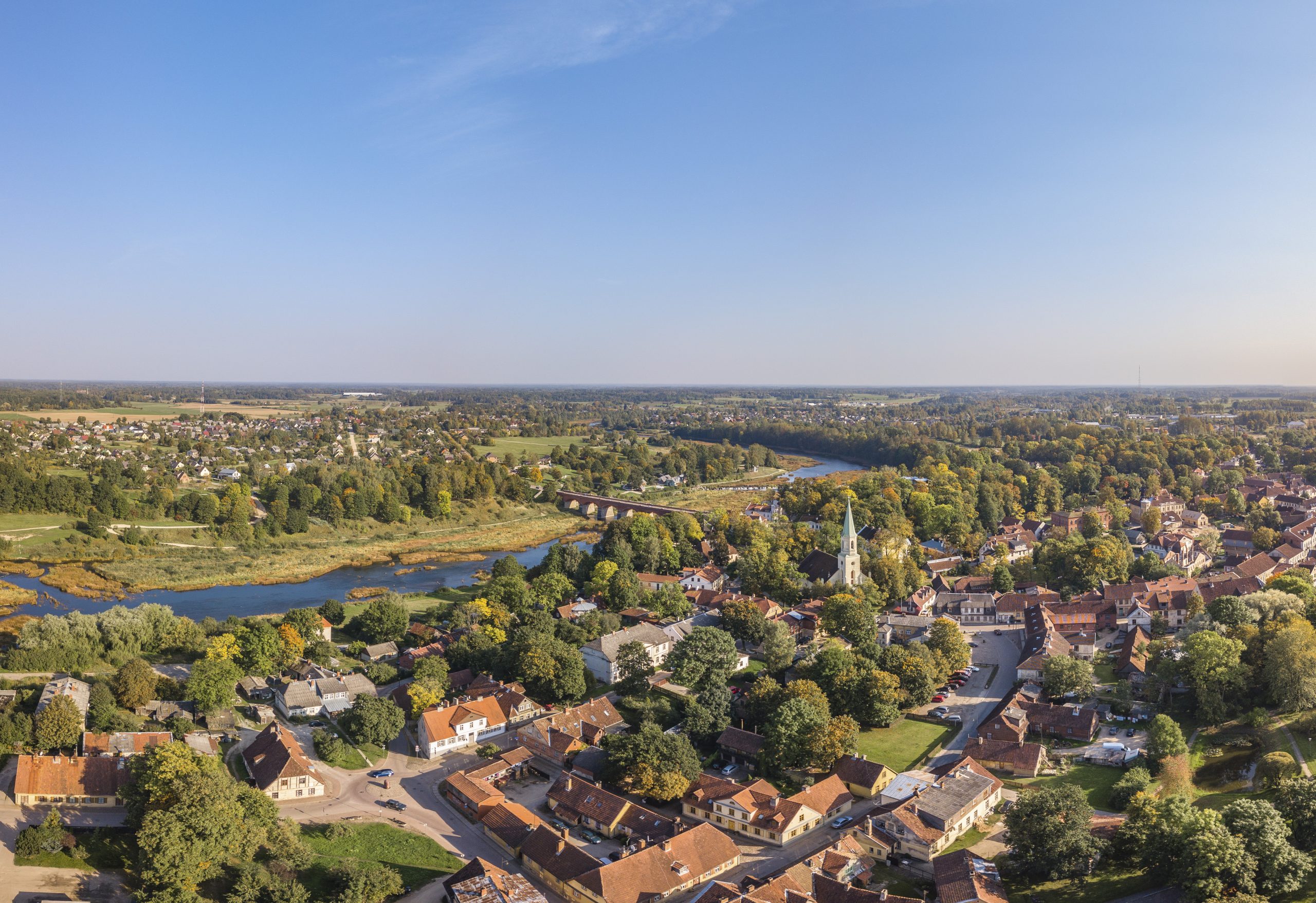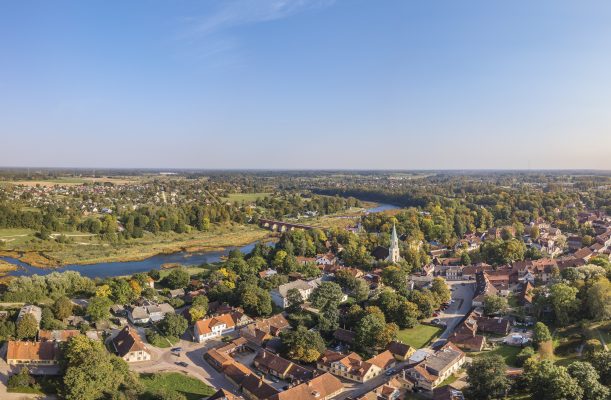Latvia has nominated Kuldiga for the UNESCO World Heritage List. On Wednesday, January 20, the nomination submission was signed by the Minister of Culture Nauris Puntulis, in the presence of Kuldīgas County Council Chairperson Inga Bērziņa, Foreign Affairs Minister's Advisor Gunda Reire, Kuldīgas County Construction Board Manager, Doctor of Architecture Jana Jākobsone, Secretary General of the Latvian National Commission for UNESCO Baiba Molnīka and National Culture to Juris Dambis, head of the heritage administration.
The idea of applying Kuldīga to the UNESCO world heritage list is old - it arose immediately after Latvia ratified the United Nations Educational, Scientific and Cultural Organization (UNESCO) Convention on the Protection of World Cultural and Natural Heritage in 1997. Work on the development of the nomination began in 2001 during the time of the then mayor of Kuldīga, an architect by profession, Edgars Zalans. Inga Bērziņa, who has been in charge of the municipality since 2007, continues what was started under his leadership and Kuldīga's progress towards UNESCO is supported.

"I am honored for the opportunity to sign Latvia's application for nomination to the UNESCO World Heritage List for the second time during my tenure as a minister. Exactly one year ago, Grobiņa confirmed its commitment to apply for this nomination, but today - our city - the pearl of cultural heritage, Kuldīga. The nomination of Kuldīga, highlighting the urban structure created during the Duchy of Kurzeme and Zemgale, reflects the important role of the society as carriers of tradition in the preservation of cultural heritage. The municipality of Kuldīgas district, with its cohesive and enthusiastic team, has proven itself as an excellent host on the Latvian scale, creating an example of good practice in preserving the historic center of a protected city, making investments, involving residents and inspiring with their example," emphasizes Culture Minister Nauris Puntulis.
"Today is a big day for Kuldiga, because the period of twenty years during which we have worked and walked this path to reach the application for the UNESCO World Heritage List has ended. I want to express my belief that Kuldīga will enter the UNESCO World Heritage List, and it will be a great success not only for Kuldīga, but for the whole of Latvia. Today, I would like to say a very big thank you to the people of Kuldīdz, the residents, because clearly during these years the understanding of the heritage in which we live has been formed and grown, and the residents have both appreciated it, preserved it and developed it, because only all of us together, taking care of it and thinking about it, we can be worthy of being on the UNESCO World Heritage List," said the chairperson of Kuldīga County Council Inga Bērziņa at the event. She thanked the former mayor of Kuldīga, Edgars Zalānas, who came up with this daring idea many years ago, and Jana Jākobsone, head of the municipality's Construction Department, who has been the leader and supervisor of the nomination process for many years.

Kuldīga has been on the UNESCO National List of Latvia since 2004. In order for the city to be applied to the World Heritage List, it was necessary to arrange the historical center of the city, develop management and development plans, identify the values of the city of Kuldīga, preserve them and purposefully restore them. The cooperation of the city's residents, building owners, managers and the municipality of Kuldīga district, which has become an integral part of the management of the historical center, is very important. In 2011, the Kuldīga Old Town Preservation and Development Plan was approved, which comprehensively includes various aspects of the preservation of cultural and historical heritage, integrating them in the sections of economic development, environmental protection, tourism and cultural development. He also worked carefully and for a long time, researching and popularizing the city's historical architecture and urban planning, landscape and natural values, as well as intangible cultural heritage. The cultural and historical heritage of Kuldīga is managed very purposefully, paying special attention to the preservation of original values, observing the principles of authenticity and nurturing the overall integrity of the historical urban environment.
Following the recommendation of the Assembly of the Latvian National Commission for UNESCO, in 2018, the municipality of Kuldīga district attracted a group of international experts and students from the Institute of Heritage Management of Brandenburg Technical University under the leadership of Professor Brita Rudolfa to prepare the nomination. After careful research, B. Rudolfa suggested that the justification of the universal value of Kuldīga's special significance should be based on the context of the period of the Duchy of Kurzeme - Zemalle.
Latvia is currently represented on the UNESCO World Heritage List by the Riga Historical Center (1997) and the Strūve Geodetic Circle (2005). After a longer break, in early 2020, Latvia submitted the nomination of the Grobiņa archaeological ensemble for evaluation. In 2021, Latvia also applies Kuldīga for this nomination. The submitted nominations for the World Heritage List are evaluated by the advisory body International Council of Monuments and Sites (ICOMOS). Taking into account the recommendations of experts, decisions on the inclusion of sites in the World Heritage List are made by the UNESCO World Heritage Committee.
About UNESCO World Heritage
The UNESCO World Heritage List includes the world's most important cultural and natural heritage sites that have universal value of special significance. Currently, the World Heritage List includes 1,121 sites located in 167 countries. They depict the masterpieces of the human creative spirit, as well as unique natural places of the world, which have special aesthetics, biological diversity or peculiar interaction with the development of world cultures.

About the evidence of the Kurzeme and Zemgale Duchy period in Kuldīga. Research conclusions
Starting as a small medieval settlement, Kuldīga - then Goldingen - grew and developed over the centuries, but it was the time of the Duchy of Kurzeme and Zemgale that allowed Kuldīga to really flourish and become a regional craft and trade center. During the duchy, Kuldīga even became the residence of the ruler, thus gaining influence and importance in the region and also internationally. Since the Duchy of Kurzeme and Zemgale existed for more than two centuries, it shaped the city much longer than the influence of Russia or the existence of the Republic of Latvia. Thus, the duchess influences the spirit of Kuldīga even today.
As the first residence and an important administrative center of the ruler of the Duchy of Kurzeme and Zemgale, Kuldīga is unique in that it best portrays the Duchy and its growth, international trade and cultural exchange to the world. The historical center of Kuldīga is the best-preserved and last remaining evidence of the urban environment, which is reflected in the preserved layout of streets and squares, authentic architectural elements, building constructions and facades, as well as preserved landscape elements.
Evidence of the time of the duchy in Kuldīga was recorded by analyzing the oldest map of Kuldīga made by Friedrich Babst in 1797, comparing it with newer maps and the situation today, by surveying and photographing the evidence of buildings and the rest of the time of the duchy.
In total, 93 buildings were surveyed and photographed in the area covered by the 1797 Kuldīga map. It has been concluded that 36 buildings were built before the end of the 18th century and have survived. Of these, 17 buildings have preserved the extent of a building built before the end of the 18th century. On the other hand, 19 buildings were rebuilt, visually changing their original form, but preserving the structures of buildings built until the end of the 18th century. The most important examples can be named St. St. Catherine's Church, the Holy Trinity Roman Catholic Church, buildings at 4 Raini Street, 10 Baznīcas Street, or Duke's Pharmacy, 17 Baznīcas Street, or the Steffenhagen House, as well as the bell tower of Peter's Chapel, which marks the oldest cemetery in the city. The other buildings are also significant, such as the building at Pasta Street 5, where the 18th century window, window frames and shutters with fittings have been preserved, which is considered to be the oldest known window in Kuldīga. In several buildings, the constructions of mantle chimneys from the duchy have been preserved.
After surveying the buildings built later, it was concluded that the architectural form of 57 buildings preserved the features of the houses of the Duchy of Courland, including 42 buildings built before the end of the 18th century. In general, the buildings that have survived, as well as the buildings that were built later, following the traditions of that time, characterize the construction of the Duchy of Kurzeme and form a visual image of the urban environment of that time.
While researching and mapping the urban environment of the Duchy of Kurzeme in Kuldīga, in addition to buildings, other characteristic elements of the urban environment were also evaluated, which can be found in the visual materials of that time - maps, drawings, graphics: street network and roads, squares, water bodies, their crossing points and crossings (bridges , bridges), terrain and landscape-forming elements.
It was concluded that 100% of all the main streets (roads) visible in the 18th century plan and about 95% of cross streets have been preserved within the boundaries of the old town. Of the water bodies, both Venta, Aleksupīte and Pipevalks have survived, and in general, it can be noted that the water bodies in the territory of the old town have survived to the extent of at least 60% of those shown on the map of 1797, while the terrain with the castle fortification ramparts in a slightly transformed form – almost 100% in volume. The hub and rapids, prominent in all known 18th-century drawings and paintings, are still visible in full today.
Also, 80% of the Alekšupīte crossings are still visible in the urban environment, although the number of bridges has increased from 5 to 11. Of the squares marked on the map of 1797, 40% have completely preserved their original function, while 60% have been partially or completely transformed into publicly accessible, combining different functions territory. Scenically important and belonging to the green zone, 100% of the relief of the Ventas coast has been preserved to this day. The rest of the green area, which includes greenery and cemeteries, has remained in the range of about 30-40% from the situation in 1797 to our days.
The more than two-century-long period of the Duchy of Kurzeme and Zemgale is important in the world's cultural memory and in the aspect of the development of the city of Kuldīga, as well as in the historical center of Kuldīga, there is still a large presence and influence of the evidence of this period in the overall cultural landscape, especially in the mood of the environment and at the level of feelings. The old town of Kuldīga has preserved the heritage of different time periods, however, its homogeneous, harmonious environment is unique with the presence of abundant evidence of the Duchy period, highlighting a specific historical period unique in the world and its preserved heritage.

